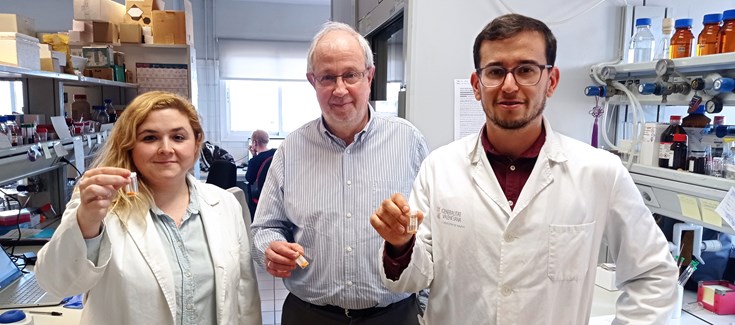Is it possible to communicate microorganisms from different kingdoms? Yes, it is, using “Nanotranslators”
CIBER, March 28 2022
Researchers from the Polytechnic University of Valencia (UPV) and the CIBER-BBN has demonstrated, for the first time, the potential of using “translator” nanoparticles to facilitate communication between different types of cells or microorganisms. His study could have application in multiple fields, especially in the medical field for the prevention and treatment of cancer.
“We have shown that it is possible to communicate microorganisms from different kingdoms using nanoparticles as translators. The nanoparticles process a message produced by the first type of cells (bacteria) and transform it into an understandable message for the second type of cells (yeast) that respond to it. In this way, the information flows from the emitting cells (bacteria) to the nanodevice and from the latter to the receiving cells (yeast), which allows communication between two microorganisms that would not otherwise interact. This is an advance in the design of nanoscale communication systems and opens the door for the development of future applications”, says Ramón Martínez Máñez, researcher at the Institute for Molecular Recognition and Technological Development (IDM) at the UPV and scientific director of the CIBER-BBN and Scientific Director of NANBIOSIS U26,”Biomedical Applications II”.
Among these future applications, the UPV-CIBER-BBN team highlights the possible regulation of the interactions between bacteria and human cells, for example, to prevent infections, kill bacteria or modulate our intestinal microbiome, and for the treatment of diseases such as cancer. “In this case, it would help cells of our immune system to recognize cancer cells more efficiently, regulating the interactions between them,” says Antoni Llopis, a CIBER-BBN researcher at the IDM Institute.
It could also be useful for designing particles that make it possible for plants and fungi to communicate with each other, which could help develop new plant protection strategies. “We could establish communication between plant cells and other microorganisms in their environment in order to prevent pests or use them as a treatment to improve plant performance,” says Ángela Morellá, a researcher at the Institute for Molecular Recognition and Technological Development (IDM) and study co-author.
In any case, the UPV and CIBER-BBN team insist that the results obtained are incipient –“it is a proof of concept”, they emphasize-, although they open a path with great potential for the field of micro/ nanotechnology and synthetic biology.
“Perhaps the biggest challenge will be reading whether the communication between those two kingdoms has been successful or not. In our study, we have used the expression of fluorescent protein by receptor cells, which facilitated the monitoring of the process. The development of future applications will require more advanced methodologies to allow the monitoring of chemical communication processes in complex biological environments”, concludes Ramón Martínez Máñez.
Article of reference
Beatriz de Luis, Ángela Morellá-Aucejo, Antoni Llopis-Lorente, Javier Martínez-Latorre, Félix Sancenón, Carmelo López, José Ramón Murguía, and Ramón Martínez-Máñez. Nanoprogrammed Cross-Kingdom Communication Between Living Microorganisms. Nano Letters 2022 22 (5), 1836-1844. DOI: 10.1021/acs.nanolett.1c02435









